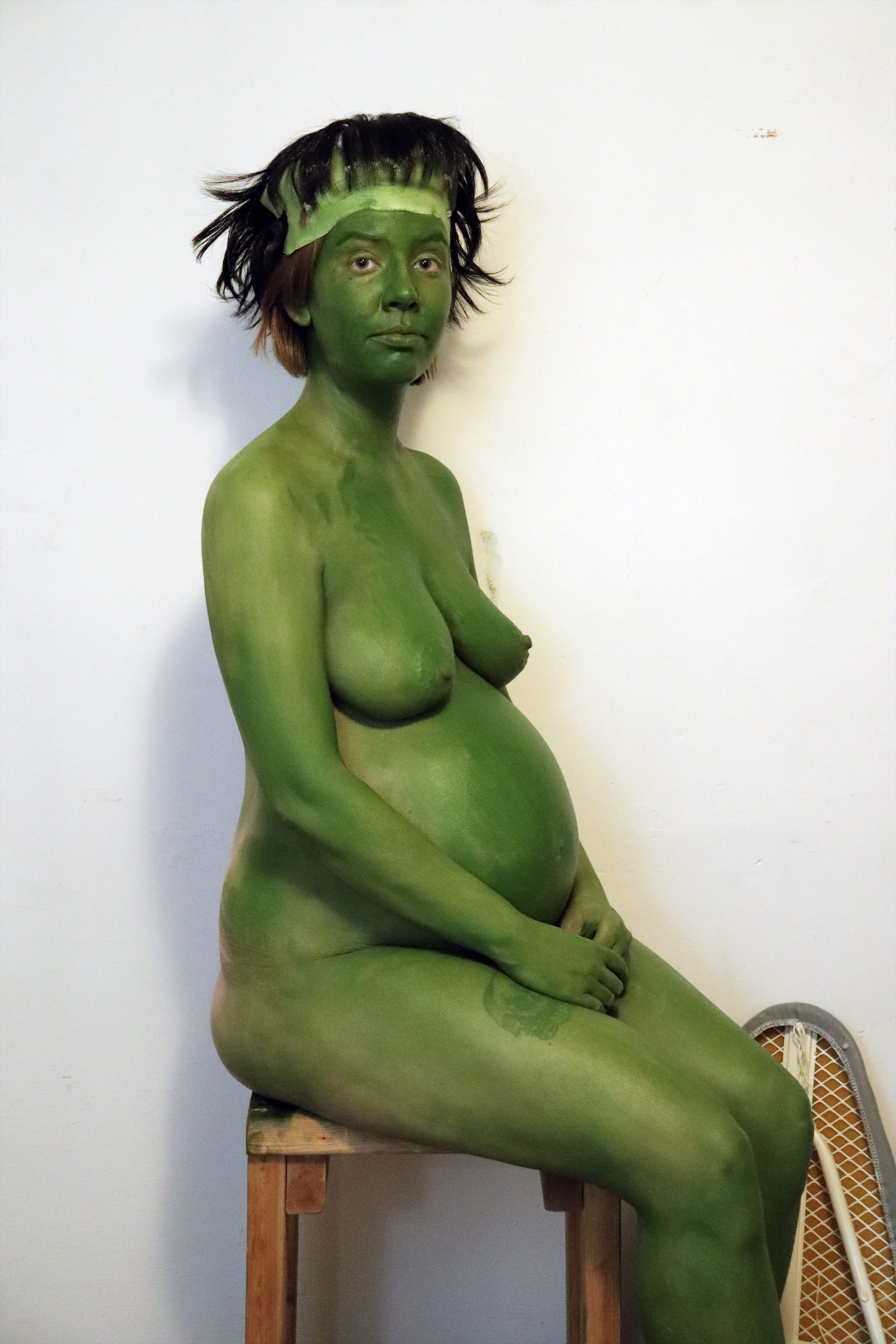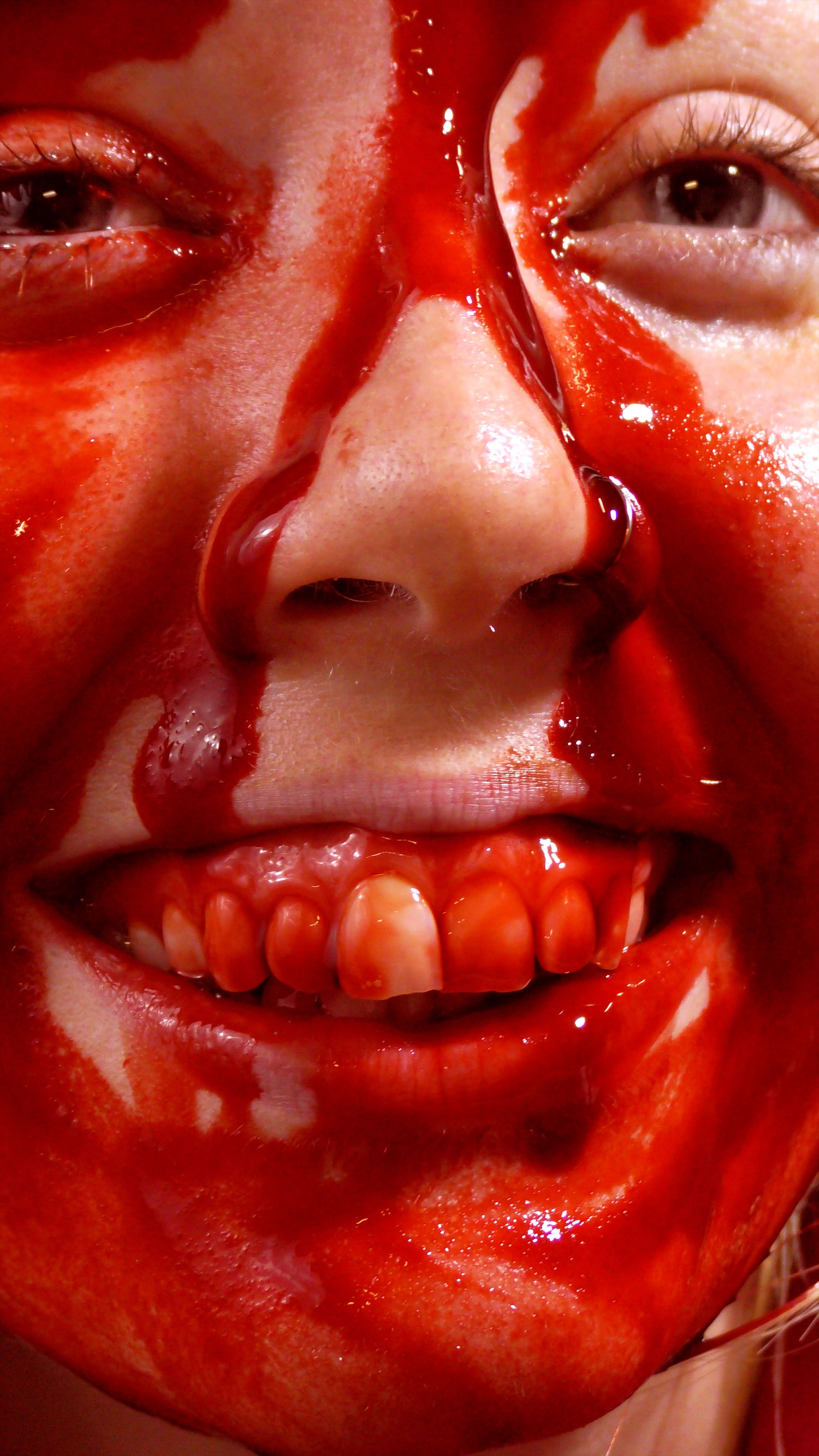Christine Bruening

Permeable Bodies
The category of horror is often discussed using “Top-down” language, as in, they keep making violent movies. However, basic economics teaches us that if there wasn’t a market for this content, they would not produce the product. In our last normal year of 2019, horror movies brought in around $790 million dollars in ticket sales in North America alone. This evidence poses the societal question of why we consume horror and what do aesthetics based on fear and gore do for us? Through this body of work, Bruening shares an autobiographical narrative navigating assault, pregnancy, the isolation of quarantine, and fear of motherhood. Throughout the work she discloses to the viewer the cathartic value that she has found within the genre of horror.
The photograph is a self-portrait, I am nude and painted head to toe in green paint with a costume store Frankenstein hat on my head. In the image, I am 39 weeks pregnant. Depending on who you speak to when you say the name “Frankenstein” they will either think of the doctor or the monster. This conflation of identity also lends itself to a conflation of responsibility. Is the doctor at fault for his hubris for bringing the monster into the world or is the monster at fault for his own actions and violence?
When I found out that I was pregnant with a boy I was terrified about my ability to raise a white male in American culture.
Throughout my pregnancy, I thought a lot about the character of Norma Bates in relation to this idea. The mother in the film Psycho is often cast as the monster despite being dead for the duration of the film. Even when this final twist is revealed at the end of the film, it never results in a transference of blame. Despite being a corpse, the film implies she is still at fault for Norman, the real killer’s actions because of her lousy job at raising him. Despite the injustice I feel on behalf of Norma, it doesn’t extradite me from the responsibility I feel to not raise the kind of man who will fade into the folds of toxic masculinity and violence in American Culture.
The physical version of this piece is printed on a satin fabric. The folds from the image being shipped are still visible in the installation, a serendipitous kind of failure as the image includes a peek of an ironing board, a nod to stereotypical notions of motherhood.

The photograph’s figure references the horror film trope of the Final Girl, a term coined by Carol J. Clover in her book “Men, Women, and Chainsaws.” In the genre, we follow The Final Girl until the end, watching her endure unspeakable terrors at the hand of some monster until she eventually emerges triumphant. Typically she manages to survive by relying on her intelligence but eventually co-opting the monster’s violence, thus, in a sense, becoming the monster herself in the end. Through the Final Girl we can ask when is or can violence be justified and who deserves vindication? For this piece, I wanted the story behind the girl to remain ambiguous. We don’t know if she is the monster or the Final Girl. We don’t know if she is covered in her own blood or the blood of someone else. Is her smile sadistic or is she relieved to have survived?
This is a video piece depicting 3 minutes of videos harvested from horror movies of, as the title implies, concerned women looking out of windows. This piece illustrates the anxiety surrounding the notion of the home and the American Dream in horror films as well as the gendered vulnerability of women within the genre. Despite the fact these women theoretically have the protection of a house, that security is fallible and the killer always gets in. When we consider this phenomenon within the context of the implication of domesticity and the notion that the home is “where a woman belongs” because it’s “safe” the anxieties presented within these films throw a wrench in that idea and make it clear that women aren’t safe no matter where they are. If we think about the house as a metaphor for the body, as something that one inhabits we can consider the invasion trope within horror as a metaphor for assault.
In the show, this piece is projected upon a window and only plays at night. The context in which the video can be viewed mimics the setting of the scenes. This parallel points to the reality of some of the anxieties presented in horror.
For the website I created a digital installation of my home. It felt important to create work that anyone in a similar situation could experience. Throughout quarantine my relationship with my home has shifted and I’ve thought a lot about the role of the home in horror, and how that speaks about our relationship with domesticity. As viewers navigate through the space they encounter different photos, 3d models and videos I’ve made over the past two years exploring the aesthetics of horror
